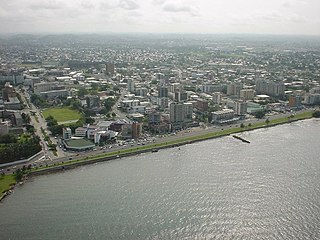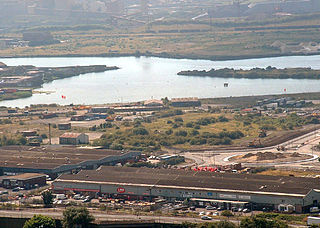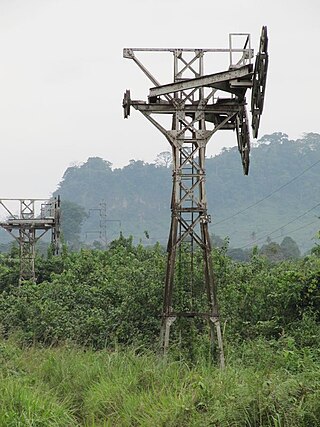Owendo Ovendo | |
|---|---|
 | |
| Coordinates: 00°17′00″N09°30′00″E / 0.28333°N 9.50000°E | |
| Country | |
| Province | Estuaire Province |
| Population (2013 Census) | |
| • Total | 79,300 |
Owendo is a port city in Gabon, forming a south western suburb of Libreville.
Owendo Ovendo | |
|---|---|
 | |
| Coordinates: 00°17′00″N09°30′00″E / 0.28333°N 9.50000°E | |
| Country | |
| Province | Estuaire Province |
| Population (2013 Census) | |
| • Total | 79,300 |
Owendo is a port city in Gabon, forming a south western suburb of Libreville.
In 1978, the Trans-Gabon Railway was connected to the city. [1]
In 2023, Fortescue Metals Group signed a deal to mine iron ore at Belinga using road and rail to reach the port of Owendo. Initially about 2m tonnes of ore would be carried.
Owendo has a cement works.

The economy of Gabon is characterized by strong links with France, large foreign investments, dependence on skilled foreign labor, and decline of agriculture. Gabon on paper enjoys a per capita income four times that of most nations of Africa, but its reliance on resource extraction industry fail to release much of the population from extreme poverty, as much of 30% of the population lives under the poverty threshold.
Modes of transport in Gabon include rail, road, water, and air. The one rail link, the Trans-Gabon Railway, connects the port of Owendo with the inland town of Franceville. While most of the country is connected by roads, not all areas are accessible. Much of the road network remains unpaved, and it primarily revolves around seven "national routes" labeled N1 through N7. The largest seaports are Port-Gentil and the newer Owendo, and 1,600 km of inland waterways are navigable. There are three international airports, eight other paved airports, and over 40 with unpaved runways. Nearly 300 km of pipelines carry petroleum products, mainly crude oil.

The Armed Forces of Gabon, officially the Gabonese Defense and Security Forces, is the national professional military of Gabon, divided into the Army, Air Force, Navy, and a National Gendarmerie, consisting of about 5,000 personnel. The armed forces includes a well-trained, well-equipped 1,800-member guard that provides security for the President of Gabon.

Libreville is the capital and largest city of Gabon. Occupying 65 square kilometres (25 sq mi) in the northwestern province of Estuaire, Libreville is a port on the Komo River, near the Gulf of Guinea. As of the 2013 census, its population was 703,904.
Makokou is the regional capital of the Ogooué-Ivindo province in Gabon. Its coordinates are 0°34′N12°52′E. Its altitude is 308 m. Its population in 2004 is around 16,600.

Port-Gentil or Mandji is the second-largest city of Gabon, and it is a leading seaport. It is the center of Gabon's petroleum and timber industries. The city is located on a delta island in the Ogooue delta. Nearby Cape Lopez is Gabon's westernmost point. As of 2013 census, it had a population of 136,462.

Ntoum or Nkan is a town in Estuaire Province in northwestern Gabon. It is the capital of the Komo-Mondah Department. Nkan lies along the N1 road and L106 road, 39.2 kilometres by road east of Libreville and 12.2 kilometres north of Nzamaligue.

The Gabon River or Gabon Estuary is a short wide estuary in the west of Gabon. The capital Libreville has a large port on the north bank of the estuary which collects water from the Komo River and River Ebe. The estuary empties into the Gulf of Guinea. The estuary is locally known as the Estuaire du Gabon.
Belinga is a location in Gabon with as yet unexploited iron ore deposits. These ore deposits extend into neighbouring Cameroon and Congo.
Iron ore production in Africa is dominated by South Africa, Mauritania and Algeria. Many countries possess iron ore deposits that are as yet untapped/unmined. Countries and companies currently involved in production are listed here; measurements are in tonnes per annum(year).

The Port of Port Talbot is located on the River Afan estuary next to Port Talbot Steelworks in the industrial town of Port Talbot, South Wales. The whole basin complex covers about 500 acres (2.0 km2), consisting of: an inner set of floating docks, developed from 1834 onwards; and an outer tidal basin, completed in 1970. Owned and operated by Associated British Ports, the tidal basin has the deepest berthing facilities in the Severn estuary and is one of only a few harbours in the UK capable of handling Capesize vessels of up to 170,000 tonnes deadweight (DWT), mostly for the import of iron ore and coal for use by nearby Port Talbot Steelworks.

Fortescue is a global metal mining and green energy company headquartered in Australia. Fortescue focused on iron ore mining under the name of Fortescue Metals Group (FMG) until July 2023. As of 2017, Fortescue is the fourth-largest iron ore producer in the world. The company has holdings of more than 87,000 km2 in the Pilbara region of Western Australia, making it the largest tenement holder in the state, larger than both BHP and Rio Tinto.
Cape Santa Clara, Gabon is a peninsula extending from the Gabon Estuary near the port of Owendo.
Railway stations in the Republic of the Congo (Congo) include:
Moanda railway station is a station on the Trans-Gabon Railway and the penultimate stop before Franceville railway station, the southern terminus of the railway. Like many stations of the Trans-Gabon, it lies outside the limits of Moanda itself, in an isolated plain. Moanda railway station lies 50 km to Franceville Railway Station and 661 km to Owendo, near Libreville. The Bangombe Plateau lies southwest to the station.

The SS St. Marys Challenger is a freight-carrying vessel operating on the North American Great Lakes built in 1906. Originally an ore boat, she spent most of her career as a cement carrier when much larger ore boats became common. After a 107-year-long working career as a self-propelled boat, she was converted into a barge and paired with the tug Prentiss Brown as an articulated tug-barge. Before conversion, she was the oldest operating self-propelled lake freighter on the Great Lakes, as well as being one of the last freight-carrying vessels on the Great Lakes to be powered by steam engines.
The following is a timeline of the history of the city of Libreville, Gabon.

The Compagnie minière de l'Ogooué, or COMILOG, is a manganese mining and processing company based in Moanda, Gabon. It is a subsidiary of the French metallurgical group Eramet. The company is the world's second largest producer of manganese ore. At first the ore was carried by a cableway to the border with the Republic of the Congo, then by rail to the sea at Pointe-Noire. In the 1980s a railway was built to carry the ore through Gabon to the sea near Libreville.
00°17′N09°30′E / 0.283°N 9.500°E